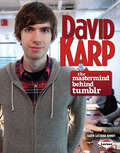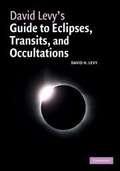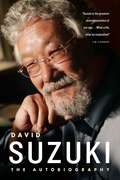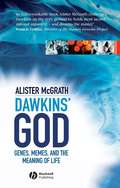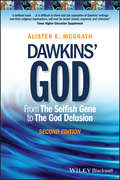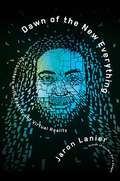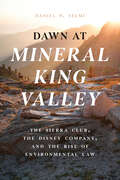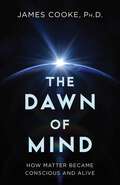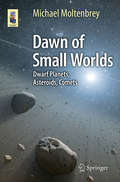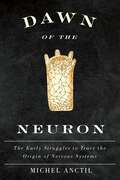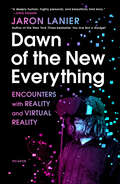- Table View
- List View
David Karp: The Mastermind behind Tumblr (Gateway Biographies Ser.)
by Karen Latchana KenneyWhat's more popular than Tumblr? This microblogging site has taken the Web by storm since its founding in 2007. Not much can top it when it comes to capturing its fans' imaginations, except for perhaps its creator, David Karp. Karp developed Tumblr after he tried to start a blog and found the process daunting. With most platforms, a blogger faces a huge, empty text box that begs to be filled with words. It was intimidating for a guy who'd never blogged before. Karp had the idea for tumblelogging—creating short blog posts—and built Tumblr as a platform. It lets users easily post both text and images, making Tumblr highly visual and expressive. Creating a different way to blog came naturally to Karp, who never does things by the book. At fifteen, he dropped out of school. At seventeen, he moved to Tokyo, holing up with a computer and fine-tuning his tech skills. He returned to the states to build a business—but to do that, he stretched the truth. He used a deep voice on the phone with potential clients so they wouldn't guess how young he was. He didn't tell anyone how little experience he had. Yet people could see he had a good thing going with Tumblr. The company quickly found support and grew into what it is today: a groundbreaking site for connection and creation. And as the mastermind behind it, Karp is sure to remain a figure to watch.
David Levy's Guide to Eclipses, Occultations, and Transits
by David H. Levy"In this simple guide, David Levy inspires readers to experience the wonder of eclipses and other transient astronomical events for themselves. Covering both solar and lunar eclipses, he gives step-by-step instructions on how to observe and photograph eclipses. As well as explaining the science behind eclipses, the book also gives their historical background, discussing how they were observed in the past and what we have learned from them. This personal account contains examples from the 77 eclipses the author has witnessed himself. The guide also includes chapters on occultations of stars and planets by the Moon and of asteroids by stars, and the transits of Mercury and Venus. Tables of future eclipses make this invaluable for anyone, from beginners to practised observers, wanting to learn more about these fascinating events"--
David Suzuki
by David SuzukiDavid Suzuki's autobiography limns a life dedicated to making the world a better place. The book expands on the early years covered in Metamorphosis and continues to the present, when, at age 70, Suzuki reflects on his entire life - and his hopes for the future. The book begins with his life-changing experience of racism interned in a World War II concentration camp, and goes on to discuss his teenage years, his college and postgraduate experiences in the U.S., and his career as a geneticist and then as the host of The Nature of Things. With characteristic candor and passion, he describes how he became a leading environmentalist, writer, and thinker; the establishment of the David Suzuki Foundation; his world travels and meetings with luminaries like Nelson Mandela and the Dalai Lama; and the abiding role of nature and family in his life. David Suzuki is an intimate and inspiring look at a modern-day visionary.
Dawkins' GOD
by Alister E. McgrathAlister E. McGrath is one of the world's leading theologians, with a doctorate in the sciences. Richard Dawkins is one of the bestselling popular science writers, with outspoken and controversial views on religion. This fascinating and provoking work is the first book-length response to Dawkins' ideas, and offers an ideal introduction to the topical issues of science and religion.Addresses fundamental questions about Dawkins' approach to science and religion: Is the gene actually selfish? Is the blind watchmaker a suitable analogy? Are there other ways of looking at things? Tackles Dawkins' hostile and controversial views on religion, and examines the religious implications of his scientific ideas, making for a fascinating and provoking debate Written in a very engaging and accessible style, ideal to those approaching scientific and religious issues for the first time Alister McGrath is uniquely qualified to write this book. He is one of the world's best known and most respected theologians, with a strong research background in molecular biophysics A superb book by one of the world's leading theologians, which will attract wide interest in the growing popular science market, similar to Susan Blackmore's The Meme Machine (1999).
Dawkins' God: From The Selfish Gene to The God Delusion
by Alister E. McGrathA fully updated new edition of a critically acclaimed examination of the theories and writings of Richard Dawkins by a world-renowned expert on the relation of science and religion Includes in-depth analysis of Dawkins’ landmark treatise The God Delusion (2006), as well as coverage of his later popular works The Magic of Reality (2011) and The Greatest Show on Earth (2011),and a new chapter on Dawkins as a popularizer of science Tackles Dawkins’ hostile and controversial views on religion, and examine the religious implications of his scientific ideas including a comprehensive investigation of the ‘selfish gene’ Written in an accessible and engaging style that will appeal to anyone interested in better understanding the interplay between science and religion
Dawn Of The New Everything: Encounters With Reality And Virtual Reality
by Jaron LanierBridging the gap between tech mania and the experience of being inside the human body, Dawn of the New Everything is a look at what it means to be human at a moment of unprecedented technological possibility. <p><p> Through a fascinating look back over his life in technology, Jaron Lanier, an interdisciplinary scientist and father of the term “virtual reality,” exposes VR’s ability to illuminate and amplify our understanding of our species, and gives readers a new perspective on how the brain and body connect to the world. An inventive blend of autobiography, science writing, philosophy and advice, this book tells the wild story of his personal and professional life as a scientist, from his childhood in the UFO territory of New Mexico, to the loss of his mother, the founding of the first start-up, and finally becoming a world-renowned technological guru. <p> Understanding virtual reality as being both a scientific and cultural adventure, Lanier demonstrates it to be a humanistic setting for technology. While his previous books offered a more critical view of social media and other manifestations of technology, in this book he argues that virtual reality can actually make our lives richer and fuller.
Dawn at Mineral King Valley: The Sierra Club, the Disney Company, and the Rise of Environmental Law
by Daniel P. SelmiThe story behind the historic Mineral King Valley case, which reveals how the Sierra Club battled Disney’s ski resort development and launched a new environmental era in America. In our current age of climate change–induced panic, it’s hard to imagine a time when private groups were not actively enforcing environmental protection laws in the courts. It wasn’t until 1972, however, that a David and Goliath–esque Supreme Court showdown involving the Sierra Club and Disney set a revolutionary legal precedent for the era of environmental activism we live in today. Set against the backdrop of the environmental movement that swept the country in the late 1960s and early 1970s, Dawn at Mineral King Valley tells the surprising story of how the US Forest Service, the Disney company, and the Sierra Club each struggled to adapt to the new, rapidly changing political landscape of environmental consciousness in postwar America. Proposed in 1965 and approved by the federal government in 1969, Disney’s vast development plan would have irreversibly altered the practically untouched Mineral King Valley, a magnificently beautiful alpine area in the Sierra Nevada mountains. At first, the plan met with unanimous approval from elected officials, government administrators, and the press—it seemed inevitable that this expanse of wild natural land would be radically changed and turned over to a private corporation. Then the scrappy Sierra Club forcefully pushed back with a lawsuit that ultimately propelled the modern environmental era by allowing interest groups to bring litigation against environmentally destructive projects. An expert on environmental law and appellate advocacy, Daniel P. Selmi uses his authoritative narrative voice to recount the complete history of this revolutionary legal battle and the ramifications that continue today, almost 50 years later.
Dawn of Mind: How Matter Became Conscious and Alive
by James CookeAlthough consciousness is at the very center of who we are, its exact nature continues to confound modern science. From where does consciousness originate? At our core, are we material bodies or immaterial conscious minds? Many assume that consciousness is a product of our complex brains, a product of evolution—and yet, there is no evolutionary reason that a mechanical function of the brain should allow us to enjoy the beauty of a sunrise or become intoxicated with the smell of rain on dry earth. If consciousness is not the product of sophisticated human brains, might the nonhuman living world be conscious? If so, where does that place us in relation to the rest of life on Earth—and what does this imply about our domination and plundering of the natural world for resources? Dr. James Cooke is no stranger to intricate and existential questions such as these, and he confronts them head-on in his compelling, inventive, revolutionary new book, The Dawn of Mind. Weaving together cutting-edge science and the contemplative insights that arise from mystical experience, as occurs with meditation and the emerging therapeutic paradigm of psychedelic medicine, Cooke radically redraws our understanding of what it truly means to be who we are.Though Cooke approaches the question of consciousness from a rigorous, scientific stance, his first foray into the study of consciousness was an intensely personal one. On a bus ride through Colchester, the ancient Roman capital of Britain, Cooke spontaneously felt himself feeling intensely and fully connected with the natural world around him; his sense of self fell away entirely. This transcendent moment inspired years of scientific study and the contemplative exploration of personal mystical experiences, leading Cooke to a stunning revelation: our sense of self is not an objective fact but an illusion, a survival technique we use to try and find order in a disorderly world. We each construct a boundary between ourselves and the natural world, constantly simulating what will happen around us in order to survive and navigate our surroundings. (Consider this: how long would you make it if you were crossing a busy street and only reacted to an oncoming car reflexively, once you felt its touch on your skin?) Unlike the self, however, consciousness is no such illusion, and is the product of the very same survival process – it is the simulation in which our sense of self appears. Of course, we aren&’t the only creatures who function in this way. According to Cooke, consciousness is not complex brain function that only we possess but a deeply embodied phenomenon, an essential feature of being a living thing. Sure, we aren&’t conscious in the same way as a tree or a worm, but as living things we are all conscious; just maybe, this notion of our dominion over all other life on earth was a ruse all along. Understanding consciousness in this way is not just some theoretical exercise. As climate change amplifies by the day, a growing chorus of voices insists that our fundamental disconnect from nature is at the root of our ecological crisis. Healing the divide between nature and consciousness may be the key to extricating ourselves from this dire predicament.
Dawn of Small Worlds: Dwarf Planets, Asteroids, Comets (Astronomers' Universe)
by Michael MoltenbreyThis book gives a detailed introduction to the thousands and thousands of smaller bodies in the solar system. Written for interested laymen, amateur astronomers and students it describes the nature and origin of asteroids, dwarf planets and comets, and gives detailed information about their role in the solar system. The author nicely reviews the history of small-world-exploration and describes past, current and future space craft missions studying small worlds, and presents their results. Readers will learn that small solar system worlds have a dramatically different nature and appearance than the planets. Even though research activity on small worlds has increased in the recent past many of their properties are still in the dark and need further research.
Dawn of the Neuron: The Early Struggles to Trace the Origin of Nervous Systems
by Michel AnctilIn science, sometimes it is best to keep things simple. <P><P>Initially discrediting the discovery of neurons in jellyfish, mid-nineteenth-century scientists grouped jellyfish, comb-jellies, hydra, and sea anemones together under one term - "coelenterates" - and deemed these animals too similar to plants to warrant a nervous system. In Dawn of the Neuron, Michel Anctil shows how Darwin's theory of evolution completely eradicated this idea and cleared the way for the modern study of the neuron. Once zoologists accepted the notion that varying levels of animal complexity could evolve, they began to use simple-structured creatures such as coelenterates and sponges to understand the building blocks of more complicated nervous systems. Dawn of the Neuron provides fascinating insights into the labours and lives of scientists who studied coelenterate nervous systems over several generations, and who approached the puzzling origin of the first nerve cells through the process outlined in evolutionary theory. Anctil also reveals how these scientists, who were willing to embrace improved and paradigm-changing scientific methods, still revealed their cultural backgrounds, their societal biases, and their attachments to schools of thought and academic traditions while presenting their ground-breaking work. Their attitudes toward the neuron doctrine - where neurons are individual, self-contained cells - proved decisive in the exploration of how neurons first emerged. Featuring photographs and historical sketches to illustrate this quest for knowledge, Dawn of the Neuron is a remarkably in-depth exploration of the link between Darwin's theory of evolution and pioneering studies and understandings of the first evolved nervous systems
Dawn of the Neuron: The Early Struggles to Trace the Origin of Nervous Systems
by Michel AnctilHow Darwin's theory of evolution drove generations of zoologists to search for the first evolved nervous systems in simple organisms.
Dawn of the New Everything: Encounters with Reality and Virtual Reality
by Jaron LanierNamed one of the best books of 2017 by The Economist, The Wall Street Journal, & VoxThe father of virtual reality explains its dazzling possibilities by reflecting on his own lifelong relationship with technologyBridging the gap between tech mania and the experience of being inside the human body, Dawn of the New Everything is a look at what it means to be human at a moment of unprecedented technological possibility. Through a fascinating look back over his life in technology, Jaron Lanier, an interdisciplinary scientist and father of the term “virtual reality,” exposes VR’s ability to illuminate and amplify our understanding of our species, and gives readers a new perspective on how the brain and body connect to the world. An inventive blend of autobiography, science writing, philosophy and advice, this book tells the wild story of his personal and professional life as a scientist, from his childhood in the UFO territory of New Mexico, to the loss of his mother, the founding of the first start-up, and finally becoming a world-renowned technological guru.Understanding virtual reality as being both a scientific and cultural adventure, Lanier demonstrates it to be a humanistic setting for technology. While his previous books offered a more critical view of social media and other manifestations of technology, in this book he argues that virtual reality can actually make our lives richer and fuller.
Dawn: A Proton's Tale of All That Came to Be (BioLogos Books on Science and Christianity)
by Gijsbert Van den Brink Cees Dekker Corien OranjeThis is an adventure that began almost fourteen billion years ago, one that so often threatened to fail. It's truly a miracle I'm still here. Despite everything, I wouldn't have wanted to miss one second of it. And the best is yet to come.With the help of an extraordinary narrator, you're invited to discover the wonder and drama of the history of the cosmos. In this story we follow the journey of one proton who comes into existence at the beginning of creation and makes it all the way through history to today. By becoming a part of atoms and molecules that turn up at some of the universe's most important moments, our friend Proton witnesses emerging galaxies, the origin of life, its evolution into a wild diversity of life forms, the first human beings, the birth and life of Jesus, the beginnings of the Christian church, all the way up to the present day. Through it all, the mysterious, seemingly unbelievable plans of the Creator continue to unfold. . . .DawnBioLogos Books on Science and Christianity invite us to see the harmony between the sciences and biblical faith on issues including cosmology, biology, paleontology, evolution, human origins, the environment, and more.
Day Light, Night Light: Where Light Comes From
by Franklyn M. Branley Stacey Schuett BranleyMoonlight is really sunlight! Did you know that the moon doesn't make its own light? Instead, it receives light from the sun and reflects it to us on the Earth. Read and find out about how the sun, the stars and light bulbs make light so we can see. Did you know that moonlight is really sunlight? The moon can't make its own light, so it receives light from the sun and then sends it to us here on the Earth. Any child who's ever wondered about the fascinating properties of light will want to read this classic science title. Readers will even learn how fast light can travel: from the moon to the Earth in less than three seconds! Veteran science author Franklyn M. Branley's lively text and Stacey Schuett's new illustrations combine fun facts and hands-on activities in this accessible introduction to the science of light. Did you know that moonlight is really sunlight? The moon can't make its own light, so it receives light from the sun and then sends it to us here on the Earth. Any child who's ever wondered about the fascinating properties of light will want to read this classic science title. Readers will even learn how fast light can travel: from the moon to the Earth in less than three seconds! Veteran science author Franklyn M. Branley's lively text and Stacey Schuett's new illustrations combine fun facts and hands-on activities in this accessible introduction to the science of light.
Day One (Day Zero Duology #2)
by Kelly deVosIn the sequel to Day Zero, stepsisters Jinx and MacKenna must put aside their enmity and work together to rescue their little brother…and possibly save the world. A nonstop whirlwind of a read for fans of Marie Lu, Rick Yancey and Alexandra Bracken.RULE ONE: THOSE WHO PANIC DON’T SURVIVEIT’S AS TRUE NOW AS IT WAS THE DAY OUR WORLD EXPLODED INTO CHAOSJinxThree months ago, all I wanted was to stay up late playing video games and pretending things were fine. But with my parents’ role in a massive political conspiracy exposed, I ended up on the run, desperate to rescue my little brother, Charles, from the clutches of The Opposition.I used to hate my father’s obsession with disaster prepping. But as I fight my way across a war-torn country and into a secret military research facility with only my stepsister to count on, I realize that following Dr. Doomsday’s Guide for Ultimate Survival might be our only hope of surviving to see Charles again.MacKennaOnce, I had it all. The right backstory. The right qualifications. But my life as a student journalist was destroyed forever in the explosions that triggered the country’s meltdown. Now I’m determined to help Jinx get our little brother back. But we also have to find our own reasons to survive. Somehow, I’ve become the first reporter of the new civil war. In a world where your story is your ultimate weapon, I have to become the toughest freedom fighter of all.
Day Zero (Day Zero Duology #1)
by Kelly deVosDon’t miss the exhilarating new novel from the author of Fat Girl on a Plane, featuring a fierce, bold heroine who will fight for her family and do whatever it takes to survive. Fans of Susan Beth Pfeffer’s Life As We Knew It series and Rick Yancey’s The 5th Wave series will cheer for this fast-paced, near-future thrill ride.If you’re going through hell…keep going.Seventeen-year-old coder Jinx Marshall grew up spending weekends drilling with her paranoid dad for a doomsday she’s sure will never come. She’s an expert on self-heating meal rations, Krav Maga and extracting water from a barrel cactus. Now that her parents are divorced, she’s ready to relax. Her big plans include making it to level 99 in her favorite MMORPG and spending the weekend with her new hunky stepbrother, Toby.But all that disaster training comes in handy when an explosion traps her in a burning building. Stuck leading her headstrong stepsister, MacKenna, and her precocious little brother, Charles, to safety, Jinx gets them out alive only to discover the explosion is part of a pattern of violence erupting all over the country. Even worse, Jinx’s dad stands accused of triggering the chaos.In a desperate attempt to evade paramilitary forces and vigilantes, Jinx and her siblings find Toby and make a break for Mexico. With seemingly the whole world working against them, they’ve got to get along and search for the truth about the attacks—and about each other. But if they can survive, will there be anything left worth surviving for?
Day and Night (Cycles of Nature)
by Jaclyn JaycoxThe sun shines bright during the day, but why can't you see it at night? Follow the patterns of the sun and Earth to learn what causes day and night.
Day and Night (National Geographic Kids Readers)
by Shira EvansDuring the day, the sun shines, birds tweet, and bees buzz. Earth is awake! But what happens at night? The moon -- and a whole new group of animals come out to play! Adult and child readers can cuddle up and read aloud and learn together in this new "you read, I read" co-reader format, vetted by early reading expert Susan B. Neuman.
Day and Night in the Desert (Habitat Days and Nights)
by Ellen LabrecqueSpend a day and night in the desert! Learn about this dry habitat through the unique animals that call it home. Stand with meerkats during a watchful hunt for insects. Spot a jackrabbit taking a shaded midday nap. Join a desert tortoise as it dines on colorful cactus fruit. After dark, follow a snake as it slithers in cool, moonlit sand. What will tomorrow bring in the desert?
Day and Night in the Forest (Habitat Days and Nights)
by Ellen LabrecqueSpend a day and night in the forest! Learn about this wooded habitat through the fascinating animals that call it home. Leap from tree to tree with a squirrel searching for breakfast. Pounce with a fox on the forest floor. Soar with a red-tailed hawk as the sun sets. After dark, build a dam with a beaver. What will tomorrow bring in the forest?
Day and Night in the Rain Forest (Habitat Days and Nights)
by Ellen LabrecqueSpend a day and night in the rain forest! Learn about this lush habitat through the diverse animals that call it home. Start the morning suspended high in the canopy with a colorful toucan. Curl around a branch and bask in afternoon sun with an emerald boa. At sunset, pace the forest floor for prey alongside a sleek jaguar. After dark, spy a nocturnal sloth slowly wake after a full day of slumber. What will tomorrow bring in the rain forest?
Day and Night in the Savanna (Habitat Days and Nights)
by Mary BooneSpend a day and night in the savanna! Learn about this grassy habitat through the interesting animals that call it home. Nibble a breakfast of sky-high leaves with a giraffe. Then construct towering mounds with termites. At sunset, shriek and prowl for prey with a pack of hyenas. After dark, go on a high-speed hunt with a cheetah. What will tomorrow bring in the savanna?
Day and Night on the Prairie (Habitat Days and Nights)
by Ellen LabrecqueSpend a day and night in the prairie! Learn about this grassy habitat through the exciting animals that call it home. Spot prairie dogs popping aboveground as morning sun floods a field. Join giant bison as they graze on grass. Stir up dust on a sunset sprint with antelope. After dark, stake out prey with a coyote in dense grass. What will tomorrow bring in the prairie?
Day and Night on the Tundra (Habitat Days and Nights)
by Mary BooneSpend a day and night in the tundra! Learn about this cold habitat through the intriguing animals that call it home. Catch breakfast mid-flight with a peregrine falcon. Spend the afternoon snoozing with an Arctic fox. Take an evening trek with a herd of caribou. After dark, sit still with an Arctic hare as it hides from hungry wolves. What will tomorrow bring in the tundra?
Day's Veterinary Immunology: Principles and Practice
by Brian Catchpole Harm HogenEschMichael Day's Veterinary Immunology: Principles and Practice is the adopted text in numerous veterinary schools throughout the world. Updated and revised by Brian Catchpole and Harm HogenEsch with advances in knowledge since 2014, this third edition reflects the rapid developments in the field internationally, while preserving the strengths of Day's original writing. It adds numerous case studies demonstrating the clinical context across companion and farm animals. The textbook presents information on commonly used diagnostic test procedures and includes learning objectives at the start and key points at the end of each chapter, standard symbols in diagrams throughout the text to provide continuity, clinical examples and clinicopathological figures throughout, and a glossary of terms and list of commonly used abbreviations. Short animations are viewable via the Support Materials tab on the Routledge webpage, adding a new element of practical application. Exploring the immunological principles of both large and small animals, the book emphasizes immunological principles while applying them to disease processes and to clinical practice. It provides a practical textbook for veterinary students and a handy reference for practitioners.
